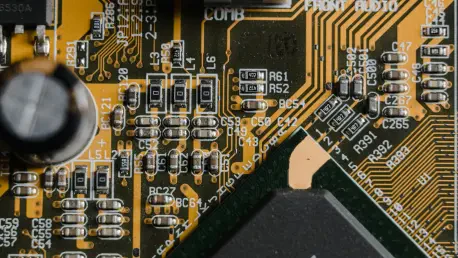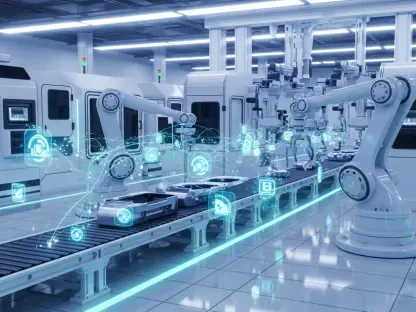The meteoric rise of Artificial Intelligence (AI) is creating seismic shifts in the global semiconductor industry, fundamentally altering the intricate web of its supply chain in ways that few could have anticipated. As AI applications proliferate—from powering massive data centers to enabling edge computing devices—the demand for highly specialized chips such as Graphics Processing Units (GPUs), Neural Processing Units (NPUs), and high-bandwidth memory (HBM) has surged beyond current manufacturing capabilities. This unprecedented need is not merely a numbers game; it represents a qualitative leap, pushing the boundaries of chip design and production to meet the intense computational requirements of AI workloads. With market projections estimating the semiconductor industry to reach $800 billion this year and potentially $1 trillion by 2030, the stakes are extraordinarily high. Data centers, often described as the beating heart of AI innovation, are fueling much of this growth, placing immense pressure on suppliers to deliver cutting-edge hardware. However, this boom exposes deep-rooted vulnerabilities in a supply chain already battered by past disruptions, from pandemics to geopolitical strife. What was once a behind-the-scenes component of technology infrastructure is now a critical battleground, as industry leaders race to adapt to these new realities. This article explores the multifaceted impact of the AI supercycle, delving into how it is redefining manufacturing strategies, competitive landscapes, and global economic policies.
Surging Demand Fuels Industry Transformation
The AI explosion is rewriting the rules of the semiconductor game, creating an insatiable appetite for specialized chips that traditional production lines are struggling to satisfy. Unlike the general-purpose processors of yesteryear, AI applications demand tailor-made solutions like GPUs and Application-Specific Integrated Circuits (ASICs), which are engineered for maximum computational power and efficiency. This shift has led to a bottleneck in the industry, as manufacturers scramble to reallocate resources and prioritize these high-value components over more conventional offerings. The urgency to meet this demand is palpable, with data centers alone driving a significant chunk of the market’s growth. Projections suggest a staggering trajectory for the industry, highlighting how AI is not just a trend but a transformative force. The challenge lies not only in scaling up production but in ensuring that innovation keeps pace with the unique requirements of AI systems, which often push the limits of current technology.
Beyond the quantitative surge, the qualitative evolution in chip design is reshaping the industry’s priorities. AI workloads require unprecedented levels of performance, necessitating advancements in both architecture and packaging techniques to optimize speed and energy use. Companies deploying AI at scale find themselves at a crossroads, where access to these advanced semiconductors can determine market leadership or obsolescence. This dynamic has sparked a race among tech firms to secure reliable supplies, often leading to strategic partnerships or in-house development of custom solutions. The ripple effects are felt across the ecosystem, as even smaller players must navigate this high-stakes environment to remain relevant. As the industry grapples with these demands, it becomes clear that the ability to innovate under pressure will define the next era of technological progress.
Vulnerabilities and Strategic Responses
The global semiconductor supply chain, already tested by historical crises, is under renewed strain from the relentless demands of AI technologies. Unlike the broad chip shortages seen during the pandemic, today’s scarcity is laser-focused on advanced components critical for AI, creating acute challenges for both industry giants and emerging players. This targeted crunch has exposed the fragility of a system built on efficiency-driven models like “just-in-time” inventory, which falters under unexpected disruptions. In response, a paradigm shift toward a “just-in-case” approach is gaining traction, emphasizing resilience through stockpiling and diversified sourcing. Major foundries, such as Taiwan Semiconductor Manufacturing Company (TSMC), are investing heavily in capacity expansion, though the multi-year timelines for new fabrication plants (fabs) mean relief is not immediate. The industry’s pivot reflects a hard-learned lesson: stability now trumps cost-saving in a world of unpredictable risks.
Past disruptions, ranging from natural disasters to geopolitical conflicts like the Russia-Ukraine war impacting neon gas supplies, continue to serve as stark reminders of the supply chain’s exposure. These events have catalyzed a broader movement to safeguard against future shocks, with companies and governments alike reevaluating their dependencies. Investments in redundant systems and alternative suppliers are becoming commonplace, even as the costs of such measures mount. The complexity of building new fabs, often requiring billions in capital and facing labor shortages, adds another layer of difficulty to these efforts. As the industry adapts, the focus is shifting toward long-term strategies that can withstand both localized and global challenges. This strategic overhaul, while necessary, underscores the delicate balance between meeting immediate AI-driven needs and ensuring sustainable operations in an uncertain landscape.
Geopolitical Risks and Industry Fragmentation
The semiconductor supply chain’s heavy reliance on a few geographic hubs, particularly Taiwan, which produces over 60% of advanced chips, presents a significant geopolitical risk in an era of heightened tensions. A potential crisis in the region could send shockwaves through global technology sectors, disrupting everything from consumer electronics to critical AI infrastructure. In response, nations are increasingly prioritizing “tech sovereignty,” seeking to reduce dependence on foreign manufacturing through policies like the U.S. CHIPS and Science Act and the EU Chips Act. These initiatives are channeling billions into domestic production capabilities, aiming to create a more secure and self-reliant industry. However, this push for localization is not without challenges, as it requires massive investment and time to replicate the expertise and scale of established hubs. The urgency to diversify production footprints is clear, yet the path forward remains fraught with obstacles.
While fragmentation of the once-globalized supply chain enhances national security, it also introduces inefficiencies that could hinder the rapid pace of AI innovation. Building new facilities in multiple regions often leads to higher operational costs and potential delays, as economies of scale are lost in the transition. This shift also risks creating a patchwork of standards and regulations, complicating international collaboration among tech firms. Policymakers and industry leaders must navigate this tightrope, balancing the need for resilience with the economic realities of a highly competitive market. As countries invest in “friendshoring”—partnering with allied nations for production—the global landscape is becoming more complex, with implications for both cost structures and technological advancement. The long-term impact of this trend will likely shape how quickly and effectively the industry can respond to AI’s evolving demands.
Competition and Hardware as the New Frontier
In the high-stakes race for AI dominance, access to cutting-edge semiconductors has emerged as a critical differentiator, reshaping competitive dynamics across the tech sector. Major players like Google, Amazon, and Microsoft are taking control of their destinies by designing custom AI accelerators, such as Google’s Tensor Processing Units (TPUs), to bypass reliance on traditional suppliers like NVIDIA. This move toward vertical integration provides a strategic advantage, allowing these giants to tailor hardware precisely to their needs while securing supply in a constrained market. Meanwhile, smaller startups find themselves at a disadvantage, often unable to secure the chip allocations necessary to scale their operations. This growing disparity highlights a fundamental shift: hardware availability is becoming just as crucial as software innovation in determining who leads the AI revolution.
The implications of this hardware bottleneck extend beyond individual companies, influencing the broader trajectory of technological progress. As chip scarcity dictates market positioning, the divide between well-resourced industry titans and emerging innovators widens, raising concerns about equitable access to the tools driving future advancements. For startups, the struggle to compete is compounded by the high costs of alternative sourcing or custom development, often stifling their growth potential. Larger firms, on the other hand, leverage their financial muscle to lock in long-term supply agreements, further cementing their dominance. This uneven playing field prompts questions about the inclusivity of the AI ecosystem and whether smaller players can carve out a space in an increasingly hardware-driven landscape. As the industry evolves, finding ways to democratize access to advanced chips will be essential for fostering diverse innovation.
Building a Resilient Future for AI Hardware
Reflecting on the transformative journey of the semiconductor industry, it’s evident that the AI supercycle exposed both critical weaknesses and remarkable adaptability within the supply chain. The targeted scarcity of advanced chips revealed how deeply intertwined AI progress was with hardware availability, while geopolitical risks underscored the dangers of concentrated production. Industry responses, from capacity expansions by leading foundries to government-backed initiatives like the U.S. and EU Chips Acts, demonstrated a collective resolve to address these challenges. Innovations in chip design, such as chiplet architectures, and the use of AI for supply chain optimization marked significant steps toward overcoming bottlenecks. Despite hurdles like high costs and environmental concerns, the commitment to resilience over efficiency signaled a profound shift in strategic thinking.
Looking ahead, the path to a stable future involves sustained investment in new fabrication facilities, with experts estimating a need for 20-25 additional fabs by 2030 to meet projected demand. Embracing automation and exploring novel materials can help alleviate labor shortages and reduce environmental impact, while fostering international collaboration could mitigate the downsides of supply chain fragmentation. Policymakers should prioritize incentives for sustainable practices alongside capacity growth, ensuring that the rush to meet AI needs doesn’t compromise long-term ecological goals. For companies, forging strategic partnerships and diversifying supplier bases will be key to navigating ongoing uncertainties. As the industry moves forward, maintaining this momentum of innovation and adaptability will ensure that AI’s vast potential isn’t limited by hardware constraints, paving the way for a more robust technological landscape.









